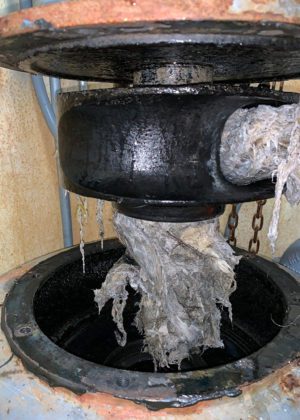
As coronavirus spread across the U.S., demand for wipes and other disinfectant products rose to unseen levels. But, as the production of disinfectant wipes has increased, so has the number of wipes clogging up Cordova’s sewer system.
Wipes with the words “biodegradable” or “flushable” printed on their packaging may not actually be safe to flush, Cordova Public Works Department officials said. While sewer blockages ordinarily occur two or three times per year, they have grown more frequent since the coronavirus pandemic began, said Water and Sewer Superintendent Joel Felix. The most recent such blockage occurred around October 2020, he said.
Though the Cordova Wastewater Treatment Plant does operate a machine that removes chunky material from sewage, wipes often get caught up before they arrive at the plant. Wipes have caused blockages at all six of Cordova’s lift stations, where pumps are used to keep sewage moving through the system. Unlike toilet paper, most disinfectant wipes, makeup remover wipes, baby wipes and similar products do not break down rapidly after being flushed.
Most of the blockages caused by wipes occur at Eyak Lift Station, which serves a densely populated area adjacent to Eyak Lake. When Felix’s five-man crew is notified that a pump isn’t running properly, they must open the pump up and clear it, which keeps three workers busy for up to a full day.
“It’s a nasty job!” remarked Public Works Director Samantha Greenwood.
Clearing blockages caused by wipes sometimes interferes with the department’s ability to promptly respond to other issues, Felix said. Blockages also cause wear and tear on pumps, requiring the city to replace them more often. Pumps cost between $7,000-$16,000 to replace, depending on the size of the pump, Felix said.
Buildup of wipes can be exacerbated by “FOG”: fat, oil and grease disposed of by pouring down drains. Grease washed out of pans with hot water may flow smoothly down the sink, but as it cools it can coat pipe interiors and other surfaces. Most dumped fat, oil and grease comes from restaurants and from industrial facilities, such as canneries, that operate large kitchens, Felix said.

Restaurants usually deliver containers of accumulated grease to the Public Works Department’s Whitshed Road facility. However, some workers in large kitchens operate under pressure that makes it difficult for them to dispose of grease properly, Greenwood said. This is something Greenwood herself faced previously when she washed dishes for a hospital.
“You have 12 cookie sheets that had bacon on them — you’re not going to scrape each one off into the garbage can,” Greenwood said. “You’re going to put hot water on them and wash them.”
For individuals, a recommended method to dispose of cooking grease is to wait for the grease to cool, seal it in a container and put it in the trash, Greenwood said.
From time to time, Felix also finds harder-to-explain clogs including materials such as floor rugs. Felix joked that he’s still waiting for the day he finds a gold ring in the plant’s chunk-removing machine.
The community at large will, ultimately, bear the cost of clearing blockages and replacing equipment, Greenwood said. Throwing wipes in the garbage rather than flushing them is one good way residents can keep their utilities rates low, she said.
Production of disinfectant wipes rose to unprecedented levels in 2020, with The Clorox Company boosting production of its disinfecting products by 40%, and pausing production of its line of compostable cleaning wipes in order to prioritize disinfectant wipes, Clorox CEO Benno Dorer told trade magazine Nonwovens Industry. The expansion of the global wipes market has also been boosted by the growth of the personal care industry, according to a report by marketing research firm The Insight Partners. The key advantage of wipes over alternatives such as liquid dispensers and paper towels is their convenience, according to the report. The wipes market accounted for $4.5 billion in 2018, and is projected to reach $16.2 billion by 2030, according to the report.





